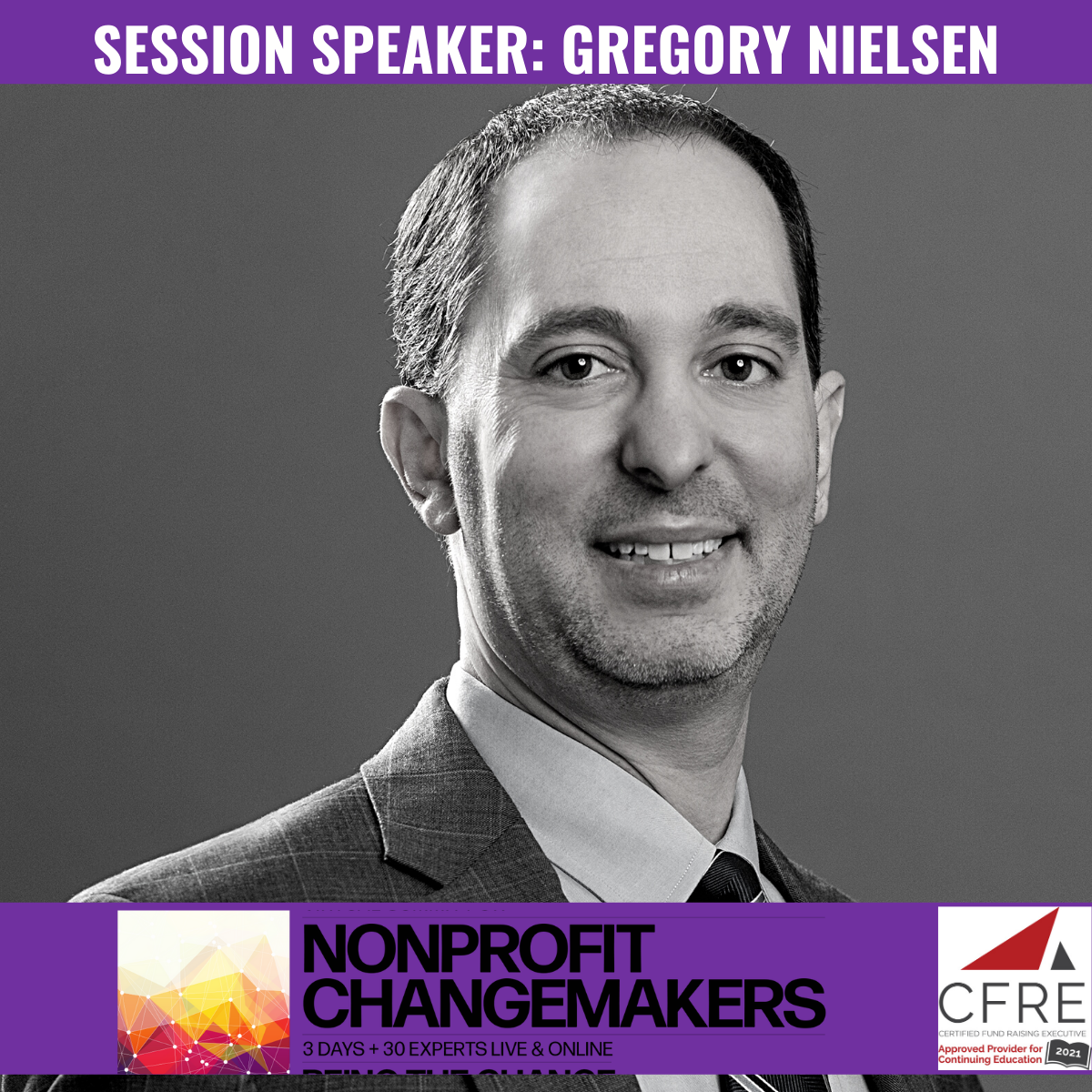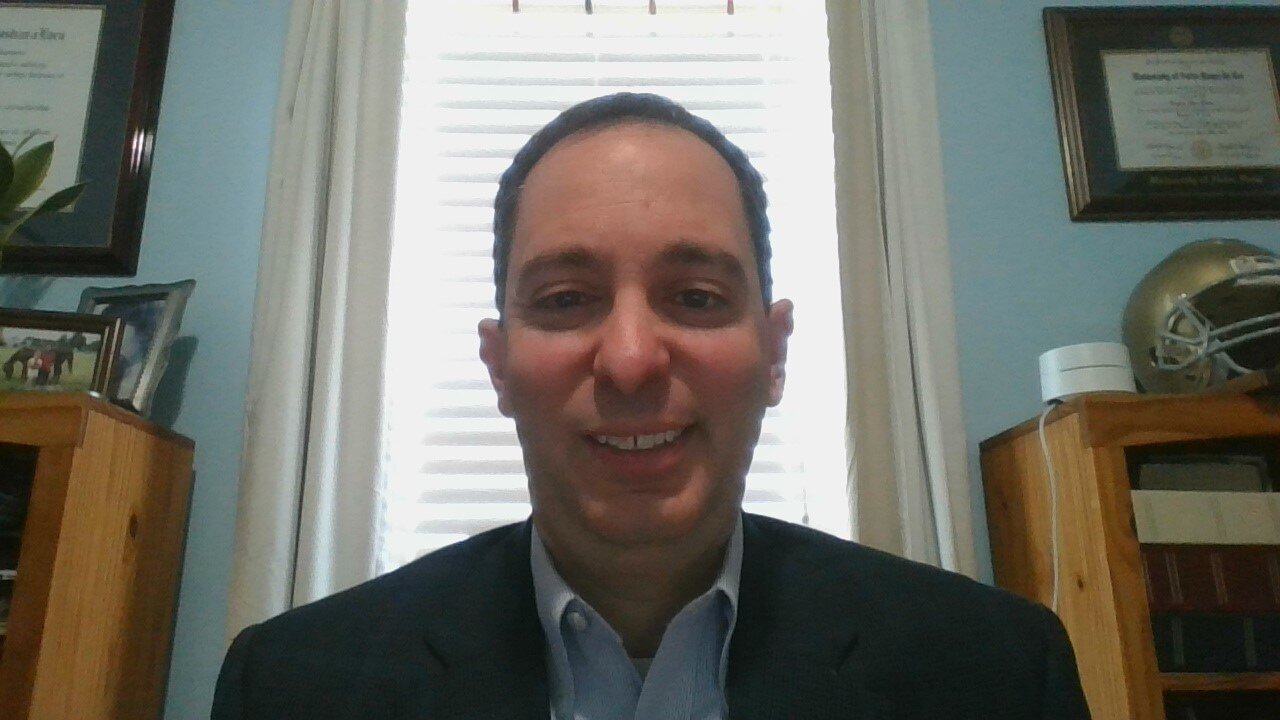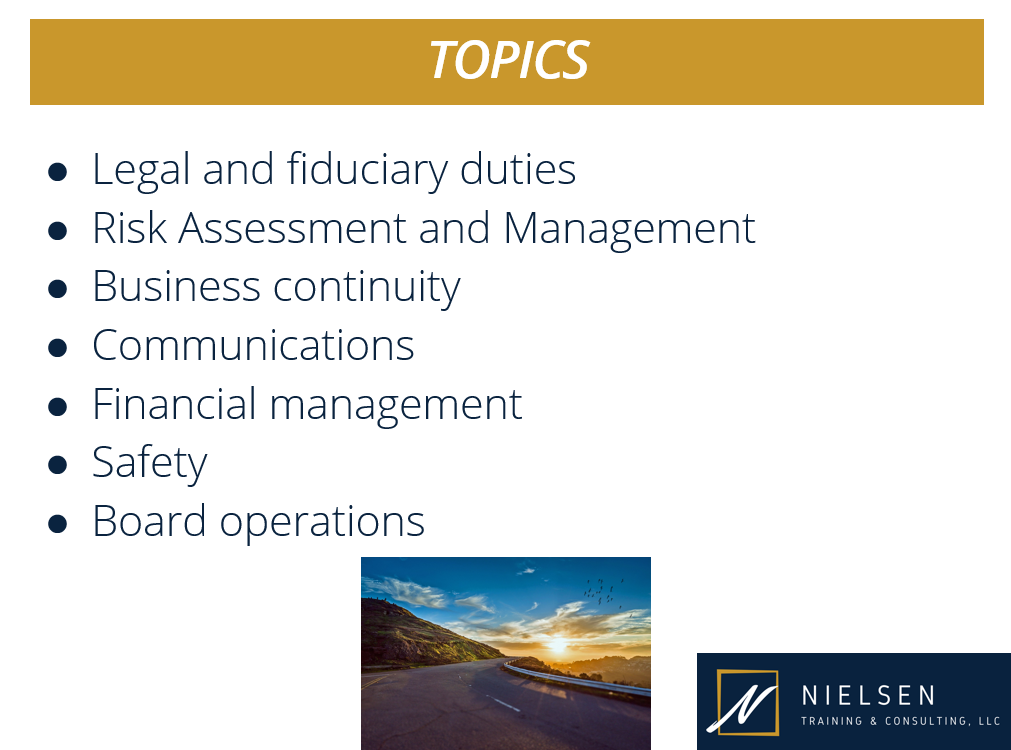
Latest News
Leading Effective "Hybrid" Board Meetings
Leading an effective Board meeting can be challenging under the best of circumstances. How is our attendance? Are there any contentious issues on the horizon? From preparing the agenda to promoting engagement and discussion, Board meetings require a high degree of thoughtfulness and intentionality. Today, many nonprofit and Board leaders are confronting an additional challenge -- namely, how do we lead effective meetings in a “hybrid” environment.
A “hybrid” environment refers to a situation where some Board members are physically in the room for the meeting while others are joining virtually. This has become a common situation for nonprofits, especially in light of the Covid pandemic. Here are some tips and strategies to help ensure that your next Board meeting is dynamic and effective:
Develop the rules of the road… together
By its very nature, leading a Board meeting in a hybrid environment contains more moving parts and issues to manage. Take the time as a Board team to develop the norms and expectations you have of each other in order to create the most productive meeting possible. Many Board teams have developed practices such as following an organized lineup of speakers to ensure that both those in person and those attending virtually have an equal opportunity to speak and contribute to the discussion. Other items to discuss include the manner in which you will record votes on any official Board actions. You can also have fun with some of your rules, as a recent Board I worked with established a “rule” that every time a Board member starts talking while on Mute, they contribute $.25 or some other nominal amount to the donation jar. Make it fun and collaborative! Teams that take the time to develop these practices together form a greater level of ownership over their meetings.
Select a platform that’s best for your team
By now we are all familiar with the various technology platforms that exist to facilitate virtual meetings. We are well versed in their pluses and their minuses. The reality is that there is not one platform that is “best” for nonprofit Board meetings. Rather, the platform that will help lead to the most effective meetings is the one you and your Board members are most comfortable with and can navigate most easily. Before selecting a platform, check with the Board and inquire as to their familiarity with the various platforms as well as their preferences. You may find a high degree of consensus around comfort with a particular platform. Similarly, once you have selected a platform for your hybrid Board meeting, invest the time to test it with each Board member who will be joining virtually. Nothing will derail a Board meeting faster than a Board member with increasing exasperation stating “Can you hear me now?”
Plan the agenda thoughtfully
While it is always important to take a thoughtful approach in preparing a Board meeting agenda, it is even more so when leading a hybrid meeting. Give yourself and your team grace in understanding that you may not be able to get through the same volume of items in a hybrid meeting as you do in person. That’s ok! It is far more important that the Board’s time together be engaging, productive, and impactful rather than comprehensive. When constructing the agenda, remember that offering onramps for engagement and discussion is important for all Board members, regardless of how they are joining the meeting. If helpful, consider assigning roles to Board members such as facilitator, chat follower, or engagement monitor, or even securing an external facilitator comfortable with the hybrid environment. Finally, assess the most effective length for your Board meeting in this environment. If your meeting is going to last more than an hour, consider building in a break for Board members to ensure that energy and focus remain high throughout.
Engage the elephants
There are elephants in just about every Board room. Some are large, some are small, but they are those issues, conflicts, or dysfunctions that if ignored, may over time undermine the effectiveness of the Board team. The temptation when dealing with the challenges of a hybrid meeting is to ignore the elephants in the room, postponing addressing them until the Board can all be together again. Rather, be mindful of these issues and pay close attention to tone, body language, and what is not being said -- either by those in the room or those joining virtually. Where appropriate, pause to ensure that small misunderstandings don’t become large conflicts. If you see signs and signals that conflict or disagreement is brewing, assess whether it is best to pause in the moment and address it as a team or schedule a reminder to follow up individually with the team members.
By engaging the Board team in developing the norms and expectations of a hybrid meeting and then planning and facilitating the meeting in a thoughtful way, your next hybrid meeting can lead to the type of engagement and discussion that propels your mission forward. If you have further questions about creating dynamic, effective Board meetings, let’s connect!
Getting the Band Back Together
Reunions come in many different forms and for many different purposes. Class reunions. Family reunions. Team reunions. Many nonprofits are preparing for their own type of reunion over the coming weeks and months -- a Board reunion.
Over the past year or so, nonprofits have adapted to the challenges of the pandemic and most Boards have met virtually. This conversion has brought benefits such as improved attendance, and also challenges such as lack of personal interaction among Board teams. As Boards begin to return to some form of in-person gathering, here are some tips to ensure a smooth transition.
Devote time to relationship building.
While virtual platforms offer outstanding features to ensure effective meetings, many nonprofit Boards have missed that element of social interaction, of getting to know one another as colleagues and teammates. Through departures from and additions to the Board, your nonprofit may have several Board members who have never actually met one another in person. Before diving back into the business of the Board, consider the ways in which you might offer Board members an opportunity to re-engage with one another and develop the types of relationships found in healthy teams.
Tip: Consider a Board retreat or intentionally create other opportunities for Board members to get to know one another.
Assess the current strengths, challenges, and priorities of the Board.
We can’t forget that the past year has been highly disruptive for nonprofits and Boards -- personally, professionally, and organizationally. The health of your Board today may be very different (positively or negatively) than it was a year ago. Rather than assuming these changes will disappear upon a return to in-person meetings, consider pausing to assess that state of the Board.
Tip: Whether through a formal Board assessment or informal checkup, offer Board members the opportunity to reflect and hold a mirror up to the Board team -- what is going well, where are we struggling, and what are our most important priorities.
Develop new norms and expectations as a team.
Just as the strengths and challenges of the Board may have changed over the past year, the norms and expectations of the team may have evolved also. For example, many nonprofits are now evolving to a hybrid platform for Board meetings, where some members are comfortable being in-person and others more comfortable with joining remotely. Is your meeting frequency and schedule still optimal for the team or does it need to be altered? These are just a few of the questions your Board may want to address.
Tip: Board members tend to have greater ownership of norms and expectations they help create.
Know that the road is not always smooth. There may be bumps along the way. Like any team, Boards are challenging! Know that Nielsen Training & Consulting is your partner on this journey and we are here to offer any support or guidance you may need. We want to hear from you as you get the band back together!
Have You Heard the News? Nonprofit Vision is a Top 20 Podcast!
Excited to share that our podcast — Nonprofit Vision — has been named one of the Top 20 Nonprofit Leadership Podcasts You Must Follow in 2021 by Feedspot! We are #8 on the list!
With over 80 episodes available, Nonprofit Vision presents informative and entertaining conversations spotlighting critical issues in nonprofit leadership with the visionaries who are addressing them. You can find Nonprofit Vision on the NTC web site or on your favorite podcast platform such as Apple Podcasts, Google, Anchor, and more.
If you are already subscribed to the podcast, THANK YOU for helping us grow this special community of leaders! If you are not yet subscribed, check it out and let us know what you think. If you know of a nonprofit leader who might enjoy the podcast, please share it with them.
Join Me at the Upcoming Virtual Summit for Nonprofit Changemakers!
Calling all nonprofit leaders and Board members! I invite you to join me for 3 days of learning, relationship building, and thoughtful conversations at the upcoming Virtual Summit for Nonprofit Changemakers hosted by TopNonprofits. Just a few of the many highlights:
💥Dates: March 23-25
💥Approved by CFRE for up to 29 CE units
💥Keynote presentation from Vu Le
I will be leading a session on "Roads to Success for Nonprofit Mergers and Sustainable Collaborations." Join me there!
Important Changes to 2 Stimulus Programs Impacting Nonprofits
Important changes have occurred to 2 key stimulus programs impacting nonprofits and small businesses -- PPP and ERTC. Hear the latest and how they can benefit your organization!
Is Your Board Ready for a Checkup? Understanding Board Assessment: Part 1 of 2
Certain habits and routines are so familiar to us that we do them as a matter of practice. Once a year, it is recommended that we visit our doctor for a physical. Every 3,000 miles or so, we change the oil in our car. Every 6 months, we check the batteries in our smoke detectors at home. We don’t do these things because something is wrong or broken. Rather, we do them because there is value in checking in, value in a tune up, and value in establishing priorities for the future. Board assessment is similar in many ways.
In Part 1 of this 2-part blog series, explore the value of a Board Assessment as a tool for enhancing the health and performance of your Board. In Part 2, we will look at various tools and methods of Board Assessment and address frequently asked questions to maximize the impact on your Board.
Like any team, most nonprofit Boards will go through periods in which they are clicking on all cylinders and periods in which performance or effectiveness may dip. Just as having an annual physical may catch any symptoms of declining health at an early stage, so too can a Board Assessment help surface any early signals of declining effectiveness. A Board Assessment process offers the following benefits:
Greater Self Awareness
Boards are not able to address issues unless they first have a mechanism for identifying them. By providing Board members an opportunity to hold a mirror up to their own performance, a Board Assessment provides a safe and effective means of surfacing issues before they lead to conflict or dysfunction. Often, Board members will say during a discussion of the assessment results, “I had a feeling that was something we needed to address, but it is reassuring to see that others feel the same way.” On the flip side, a Board Assessment can also offer teams an opportunity to celebrate the areas in which they are thriving.
Alignment of Board Practices with Organizational Strategy
Boards, like nonprofit organizations themselves, proceed through stages of a life cycle. The practices of the Board of a fledgling nonprofit often differ from those of an established organization. Likewise, as the strategic priorities of a nonprofit evolve, so too must its Board habits to promote alignment and effectiveness. A Board Assessment helps align the priorities of the Board with the strategic imperatives of the organization.
Goal Setting
During Board retreats, I will often ask Board members, “What are your top priorities for the coming year as a Board?” Often, I will hear responses such as, “Be more engaged” or “Just be better.” While there is nothing wrong with these sentiments, they are akin to your doctor telling you at your physical to “Just be healthier.” The truth is that Boards have many responsibilities -- governance, fundraising, oversight, strategy, ambassadorship. It can seem overwhelming at times. A Board Assessment serves as an effective goal-setting process for Boards, helping members identify what’s important now (W.I.N.) and what 2-3 aspects of their governance responsibilities are most critical to address in the coming year. By providing tangible areas of focus and action steps, a facilitated Board Assessment can provide greater clarity and focus for your Board.
Be sure to check back for Part 2 of this blog series for discussion of the various types of Board Assessment and the benefits of each, along with answers to frequently asked questions! If you have additional questions about Board Assessment, or would like to explore bringing the Nielsen Training & Consulting Signature Board Champions Assessment to your organization, please reach out to us at gregory@nielsenconsults.com.
NEW Stimulus Navigator for Nonprofits
Nielsen Training & Consulting and Civitas Strategies are pleased to release a FREE resource to help you navigate stimulus funding and how to apply. The Stimulus Navigator takes you step-by-step through the key questions you need to answer to determine eligibility, forms needed, and even provides easy to complete worksheet samples.
Topics Covered:
PPP Round 1
PPP Round 2
Employee Retention Tax Credit 2020 and 2021
EIDL Advance with NEW information
Families First
Click below to access the Stimulus Navigator. If you have additional questions or would like to set up a consultation, please contact us. Stay safe and stay well friends!
6 Key Questions to Better Understand Stimulus Funding for Nonprofits
From PPP Round 2 to Employee Retention Tax Credits, EIDL to Families First, there are many pathways to stimulus funding support for your nonprofit, but so little time available to learn them all. How can you maximize your opportunity? Learn about the six questions you need to answer to get the stimulus funding your nonprofit needs and deserves.
Latest News: Stimulus Package 2020
Gary Romano of Civitas Strategies and Gregory Nielsen of Nielsen Training & Consulting discuss the impact of the potential stimulus bill on nonprofits and small businesses. We discuss what we know now, what we are hearing, and how the potential legislation could impact nonprofits and small businesses. Topics covered include:
Next round of the Paycheck Protection Program (PPP)
Direct stimulus payments for individuals and families
Charitable giving incentives
Refundable tax credits available to nonprofits and small businesses
Hope
"What do you think is the most hopeful sign to emerge from the Covid-19 crisis for nonprofits?" An interviewer asked me this fantastic question yesterday. For me, it is twofold. First, I see an unleashing of immense creativity across the nonprofit community. From the manner in which vital programs and services are delivered to the way in which teams come together to meet vital needs, to the approaches to fundraising, I am blown away by the creativity and innovation I see from nonprofit leaders. Second, the collaboration that we have always known existed far more than others recognized has blossomed during this crisis. I see leaders and organizations coming together to serve communities in ways that inspire me. I believe this blossoming of collaboration will carry forward in the shaping of a new normal across the nonprofit sector in interesting and impactful ways. So now I ask you... "What do you think is the most hopeful sign to emerge from the Covid-19 crisis for nonprofits?"
FREE Webinar: Managing the Virtual Board Meeting
Do you want to improve the effectiveness and productivity of your team's next virtual Board meeting? Join me on April 30 at 1pm for a FREE webinar in partnership with Dennis C Miller entitled
"Managing the Virtual Board Meeting: Board Leadership During a Time of Crisis."
Register below and join the discussion!
Nonprofit Leadership During Times of Crisis
I recently joined host Sabrina Sciscente on her podcast Fundraising Superheroes. We had a great discussion about nonprofit leadership during times of crisis, including action planning, relationship building, and the importance of maintaining a healthy mentality. Give it a listen!
4 Lessons Learned From the Paycheck Protection Program (So Far!)
Over the past few weeks, I have advised many nonprofit leaders as they considered and applied for the Paycheck Protection Program (PPP) created by the CARES Act. As a newly created forgivable loan program, we have all learned a great deal during this process. With the announcement from the Small Business Administration (SBA) that appropriated funds for the program have been exhausted, I thought it would be a good time to pause and reflect on lessons learned so far from the PPP process that might help nonprofits if and when the program reopens.
1 Prepare.
The single most important factor in getting nonprofits approved under the PPP in a timely fashion is preparation. While the PPP application itself is straightforward, and can be completed online in a matter of minutes, preparing to file the application requires the gathering of appropriate documentation, and attention to detail. Nonprofit leaders should ensure they have the following supporting documentation when applying (where available):
Salary and Wage Information:
Company w-2s, quarterly form 941 filings, or payroll company reports
Employer Tax Contributions: Forms or payroll reports documenting employer state and local tax contributions
Employer Benefit Contributions: Group health insurance plan invoices Retirement plan contribution reports
2. Obtain Board Approval.
At its most basic level, the PPP is a loan program from the federal government administered through individual banks. While the program provides opportunities for all or a portion of the loan amount to be forgiven, nonprofits must understand and accept that any portion not forgiven will be treated as a loan that must be repaid. It is recommended that nonprofit leaders secure Board approval to apply for the loan, and some banks may even request proof through a Board resolution.
3. Select your bank wisely.
There is no way to sugarcoat this -- the bank applicants choose to apply through unquestionably matters. Countless nonprofit leaders have experienced the frustration of broken online portals, lack of responsiveness, repeated requests for the same information already provided. Though it may be an overgeneralization, I have found that smaller, local banks have fared far better in submitting applications in a times fashion, securing approval, and disbursing funds than large mega-banks. Also, while many banks require the organization to have an existing banking relationship in order to apply, that is not universally the case. Banks accepting applications from non-account holders include:
Nonprofits may also consider applying through Paypal, Intuit, Square, and others.
4. Be meticulous in recordkeeping.
As mentioned earlier, the loan obtained under the PPP may be forgiven if specific conditions are met. While we know what the law says about the amounts that can be forgiven, the rules regarding the forgiveness process have yet to be published. Nevertheless, just as preparation was a key to a successful application, I fully expect meticulous recordkeeping to be a key to a successful request for loan forgiveness. Nonprofits should keep all receipts for amounts paid using loan funds, write hard checks where possible, keep all invoices, and be prepared to produce accurate payroll reports substantiating the use of the loan funds.
While we all await Congressional action relative to funding the PPP, it is my hope these tips provide guidance for you and your organization if and when the PPP again begins funding nonprofits. As always, Nielsen Training & Consulting is here to keep you informed, answer your questions, and partner with you.
Board Leadership in Challenging Times
Highly effective Boards remain informed and engaged throughout the year. However, the need for Board leaders to be appropriately engaged and active is heightened during challenging times. This webinar explores the ways in which nonprofit Boards should respond in times of crisis, such as many are experiencing now with the COVID-19 outbreak.
I recently led a free webinar entitled “Board Leadership in Challenging Times.” I am making the video recording of the webinar available below. If you have questions or would like to discuss ways to deepen the engagement and performance of your Board, let’s connect!
FREE Webinar: Board Leadership in Challenging Times
DATE: Thursday April 9, 2020
TIME: 1pm - 2pm eastern time
PRESENTER: Gregory Nielsen
DESCRIPTION:
Highly effective Boards remain informed and engaged throughout the year. However, the need for Board leaders to be appropriately engaged and active is heightened during challenging times. This webinar explores the ways in which nonprofit Boards should respond in times of crisis, such as many are experiencing now with the COVID-19 outbreak. Emphasis will be placed on the duties of Board members, and vital role in communications, financial management, staff safety, and governance during times of crisis.
Nonprofits and the CARES Act
This afternoon I spoke with local ABC affiliate WHAS11 News about the impact of COVID-19 on nonprofits and the potential benefits for nonprofits afforded by the CARES Act.
COVID-19: Resources for Nonprofit Leaders: March 27 2020
Nonprofit leaders, Board and staff members, and volunteers — you inspire me with your leadership and sacrifice each day. The survival of nonprofits is about far more than the ability of organizations to continue existing. It is about the survival of communities, the survival of the most vulnerable, the survival of compassion, and the survival of our values.
You are not alone. We are in this together. Below please find a new collection of resources for you this week on a variety of topics. I have also created a webinar on “Board Leadership in Challenging Times.” It provides a roadmap for your Board with actionable steps in the areas of risk management, financial assessment, business continuity and communication planning, and tips for fostering Board involvement in challenging times. If this information and webinar would be helpful for your Board, let’s connect and give your Board the tools and support to lead. I am available to serve as a thought partner, facilitator, or sounding board.
COVID-19: RESOURCES FOR NONPROFIT LEADERS: March 27, 2020
Leadership:
Two Principles for Leading Your Organization Through the COVID-19 Crisis
Source: Kellogg School of Management at Northwestern University
That Discomfort You’re Feeling Is Grief
Source: Harvard Business Review
Self Care:
Board Role/Governance:
PODCAST: Board Leadership in Challenging Times
Source: Nonprofit Vision with Gregory Nielsen
Human Resources:
My Advice On Working From Home – After 10 Years of Doing It Successfully
Source: Julia Campbell
Legislation and Advocacy:
Initial Analysis of the Coronavirus Aid, Relief, and Economic Security Act (CARES Act) (S. 748)
Source: National Council of Nonprofits
How Nonprofits Can Utilize the New Federal Laws Dealing with COVID-19
Source: Nonprofit Quarterly
Philanthropy:
Board Leadership in Challenging Times
Board leadership and engagement is vital in challenging times, and there are tangible steps Boards can and should take. Enjoyed leading a webinar today on Board Leadership in Challenging Times. We discussed risk management, financial assessment, business continuity and communication planning, and tips for fostering Board involvement in challenging times. If this information and webinar would be helpful for your Board, let’s connect and give your Board the tools and support to lead.
COVID-19: Resources for Nonprofit Leaders
This is a time of uncertainty, a time of fear, and a time when the challenges of the moment can seem overwhelming. A nonprofit Executive I spoke with yesterday captured the feelings of many when she said, "It feels as though my Board, staff, donors, and volunteers are all looking to me to be a pandemic expert and know exactly how to respond." As nonprofits around the country navigate new and rapidly changing realities, leaders are discussing:
Operational contingencies
Loss of funding
Potential shifts in Board meetings
Policy changes to address the wellbeing of staff members and those served by the mission
Status of upcoming events
To all the amazing nonprofit leaders out there, you are not alone. We are in this together. Helpful resources are being created to provide guidance during these uncertain times and I have pulled some of them together in one place for you as links below. As we navigate these choppy waters together, I am available to serve as a thought partner, facilitator, or sounding board. By supporting one another and sharing information and ideas, we will get through this together.
COVID-19: RESOURCES FOR NONPROFIT LEADERS
Leadership:
Source: Civitas Strategies
How To Quickly Set Up A Work-From-Home Program
Source: Skye HR Consulting
Running Effective Virtual #Nonprofit Meetings: 9 Best Practices for Facilitating Engagement
Source: Beth Kanter
Board Role/Governance:
Nonprofit Governance: Coronavirus and COVID-19
Source: Nonprofit Law Blog
Legislation and Advocacy:
An Appeal to Congress to Include Nonprofits in Packages for Relief and Stimulus
Source: Nonprofit Quarterly
Role of Funders and Philanthropic Response:
6 Steps for Grant Makers to Take Now to Ensure Nonprofits Recover From Coronavirus Spread
Source: The Chronicle of Philanthropy
Coronavirus ‘Rapid Response’ Funds Proliferate as Threat Grows
Source: The Chronicle of Philanthropy
Board and Executive Leadership: Coronavirus and COVID-19
The integral role of the Board in leading and partnering with the Executive and staff is heightened and magnified in times of crisis and uncertainty. As nonprofits around the country navigate new and rapidly changing realities, Board members must be active and engaged leaders. Boards should partner with the Executive to discuss:
Operational contingencies
Potential shifts in Board meetings
Policy changes to address the wellbeing of staff members and those served by the mission
Status of upcoming events
The article below from Gene Takagi of NEO Law Group highlights many of these issues and provides solid tips for Boards to consider. As we navigate these choppy waters together, we are available to serve as a thought partner, facilitator, or sounding board to discuss the unique needs of your organization.















